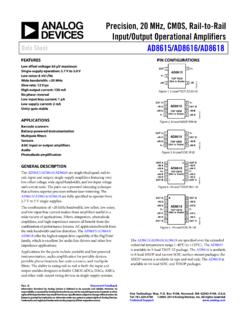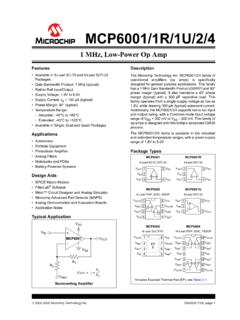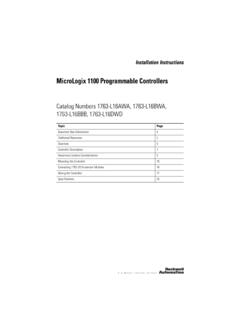Transcription of Introduction to comparators, their parameters and basic ...
1 October 2012 Doc ID 022939 Rev 11/27AN4071 Application noteIntroduction to comparators , their parameters and basicapplicationsBy Radim SmatIntroductionAfter operational amplifiers (op amps), comparators are the most generally used analog, simple integrated amplifiers are well described in many publications and a lot of information can be found regarding the design and proper use of these devices. On the other hand, information concerning comparators is much harder to find as they are often considered as simple devices. This note explains the main parameters of comparators and their limitations from an application point of and TS334 micropower low-voltage rail -to- rail ID 022939 Rev 1 Contents1 Comparator substitution by an op amp.
2 42 Comparator parameters .. 5 Comparator classification by major parameters .. 53 Datasheet parameters .. common mode voltage range - VICM .. offset voltage - VIO (VTRIP) .. and SVR .. gain .. delay .. 114 Hysteresis .. hysteresis .. hysteresis .. hysteresis, example of oscillation issue and the solution .. 195 Relaxation oscillator .. 226 Window comparator .. 247 Revision history .. 26AN4071 List of figuresDoc ID 022939 Rev 13/27 List of figuresFigure and TS334 micropower low-voltage rail -to- rail comparators .. 1 Figure pinout example .. 5 Figure comparison by TS3011 with built-in hysteresis (blue IN+, green IN-, red OUT) .. 6 Figure drain .. 7 Figure .. 7 Figure configuration.
3 7 Figure marking .. 8 Figure point VTRIP.. 8 Figure offset voltage VIO.. 8 Figure (VTRIP) measurement circuit .. 9 Figure trip point voltage vs. common mode voltage .. 10 Figure diagram .. 12 Figure diagram .. 12 Figure TPD vs. overdrive voltage .. 13 Figure TPD vs. input common mode voltage .. 13 Figure for TPD measurement .. 14 Figure point voltage definition .. 16 Figure hysteresis.. 16 Figure comparator with hysteresis.. 17 Figure comparator with hysteresis .. 17 Figure circuit example .. 19 Figure hysteresis circuit .. 19 Figure oscillation without CFB capacitor (green OUT, blue IN+), time scale 500 ns/div.. 20 Figure with CFB (green OUT, blue IN+), time scale 500 ns/div.. 20 Figure of the signal (green OUT, blue IN+), time scale 20 ns/div.
4 21 Figure oscillator .. 22 Figure comparator .. 24 Figure control circuit .. 24 Comparator substitution by an op ampAN40714/27 Doc ID 022939 Rev 11 Comparator substitution by an op ampTo use operational amplifiers in open loop as comparators is quite common. This especially applies when an op amp is already used in the application, giving the user the opportunity to use a dual channel (or quad channel) op amp which can save space in the application. This is possible even if a better alternative is to use comparators that are optimized for this purpose. The op amp is a device which is designed to be used with negative feedback. A major concern is to ensure the stability of such a configuration. Other parameters like slew rate and maximum bandwidth are trade-offs with current consumption and the architecture of an op amp.
5 comparators , on the other hand, are designed to operate in open loop configuration without any negative feedback. In most cases, they are not internally compensated. The speed (propagation delay) and slew rate (rise and fall time) are maximized. The overall gain is also usually higher. The use of an op amp as a comparator leads to an unoptimized situation, where current consumption versus speed ratio is low. The opposite is even worse. Normally, a comparator cannot be used instead of an op amp. Most probably, the comparator shows instability under negative feedback. Generally speaking, comparators and operational amplifiers cannot substitute each other except for low performance parametersDoc ID 022939 Rev 15/272 Comparator parametersComparator classification by major parameters Propagation delay Current consumption output stage type (open collector/drain or push-pull) input offset voltage, hysteresis output current capability Rise and fall time input common mode voltage major parameters , comparators are classified by other parameters such as input bias current, common mode and power supply rejection ratio, sample/hold function, and startup pinout exampleA single device has, ordinarily, five pins.
6 Two for power supply VCC+,VCC-, two as inputs IN+, IN- and one for the output OUT. It is possible to have an extra pin for standby VIN(+) > VIN(-), the output is in high state, if VIN(+) < VIN(-), the output is in low state. /546## ). 6## ). !- Comparator parametersAN40716/27 Doc ID 022939 Rev 1 Figure 3 shows the comparison made by a TS3011 comparator between a 20 m VPP input signal (blue) applied on IN+ and a 50 mV DC reference voltage (green) applied at IN-. The output signal (red) amplitude is 5 V. As can be seen, sometimes, the input signal exceeds the reference voltage though the output remains low. This is caused by the internal hysteresis voltage of the TS3011. Hysteresis is discussed in Section comparison by TS3011 with built-in hysteresis (blue IN+, green IN-, red OUT)Concerning the output configuration, there are two main types of comparators : with push-pull and open collector (or open drain).
7 Push-pull stage output levels are typically VCC and 0 V (voltage drop from power supply pins can be neglected). In the case of open collector configuration, an external pull-up resistor is used. Such a configuration allows an external voltage to be applied, different from VCC, to drive the high level state. Pull-up configuration can be used as a simple voltage level translator. The second advantage of a device with open collector is that more outputs can be connected together. This is useful for wired-OR configuration systems. It is also possible to find comparators with a differential output stage. These devices are less common and mainly used in telecommunication systems as transmission line drivers. For example, the TS3021, TS3011 and TS861 are STMicroelectronics comparators with push-pull output stage while the LMV331, TS7221 and TS331 are open drain parametersDoc ID 022939 Rev 17/27 Figure configurationFigure drainFigure 6%84!
8 - 6$$!- 6%84!- Datasheet parametersAN40718/27 Doc ID 022939 Rev 13 Datasheet input common mode voltage range - VICM The VICM is defined as the voltage range where both inputs must remain to guarantee the functionality of the device. When the input common mode range covers both power supply rails 0 V and VCC, it is a rail -to- rail input stage. Regarding the use of a rail -to- rail (R2R) comparator, from a technical point of view, if the R2R input capability is not needed, it is always better to choose a comparator without R2R input stage. The power consumption is, in that case, obviously smaller and the device cost is lower. input offset voltage - VIO (VTRIP)The input offset voltage (VIO) can be defined as the differential input voltage to apply in order to be at the toggling level.
9 input offset voltage limits the resolution of comparators . Therefore, for very small signals (in the same order as the VIO), the comparator toggles at an undesired value or does not toggle at marking Figure point VTRIP Figure offset voltage VIO 6##6/546). 6). !- 6). T6). T6/54642)0 642)0 !- 6). T6). T6)/6/54!- AN4071 Datasheet parametersDoc ID 022939 Rev 19/27In other words, input offset voltage can be represented by a voltage source applied in series with one input of an ideal comparator. Consequently, the output doesn't toggle when VIN+ = VIN-, as in the case of an ideal comparator, but the threshold level is shifted by the input offset value VIO. input offset voltage rises in the input stage as a consequence of transistor imbalance.
10 For comparators with built-in hysteresis, VIO is defined as the average value of VTRIP+ and VTRIP-, and the hysteresis of VHYST = VTRIP+ - VTRIP- where VTRIP+ (respectively VTRIP-) is the input differential voltage for which the output switches from low to high state (respectively high to low state).MeasurementInput offset voltage and trip points can be measured using the circuit shown in Figure 10. The first DC source sets the power supply VCC and the second sets VICM, the common mode voltage. A 100 m VPP triangle signal is applied on the voltage divider (1/101). The voltage divider is necessary to obtain a good accuracy on the VIO reading by the scope, and to use the function generator with an amplitude that it can handle. The triangle signal should be low frequency (20 Hz); higher frequency can lead to error in the VIO measurement caused by propagation delay of the device.


















